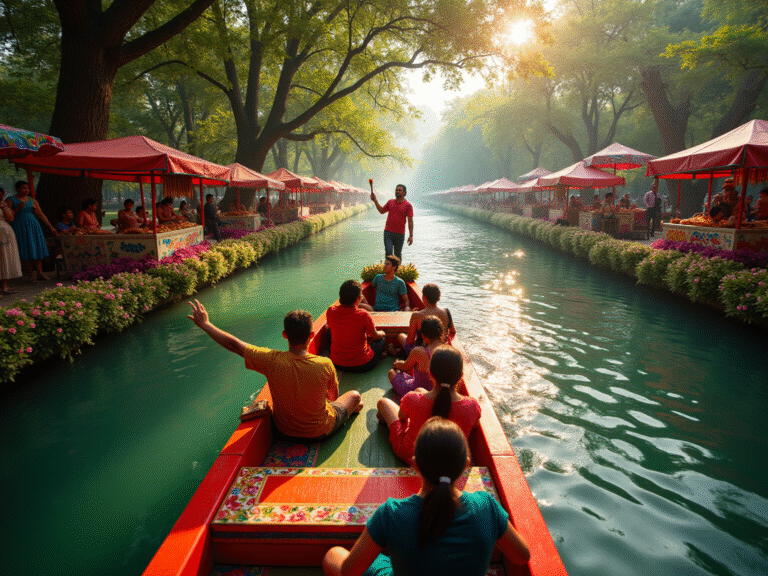Overview
This article highlights ten must-see canals in Mexico City, with a special focus on Xochimilco, a UNESCO World Heritage Site that boasts intricate canals and a rich cultural tapestry. Imagine immersing yourself in vibrant traditions and sustainable agricultural practices like chinampas! You’ll find that the area offers incredible experiences through:
- trajinera rides
- local festivals
- culinary tourism
These elements make Xochimilco a truly significant destination for cultural exploration. So, are you ready to discover the wonders of this enchanting place?
Key Highlights:
- Xochimilco, known as the ‘Venice of Mexico,’ features intricate canals and is recognized as a UNESCO World Heritage Site.
- The area spans 402,369,324 hectares, highlighting its cultural importance in preserving regional traditions.
- Challenges in tourism include limited funding for conservation projects and community conflicts, prompting a focus on sustainable practices.
- Chinampas, or floating gardens, are vital for sustainable agriculture and biodiversity, originating from Aztec innovations.
- Trajinera rides offer immersive cultural experiences, with vibrant music, food vendors, and traditional games attracting over 1.5 million visitors annually.
- Local festivals, such as the Day of the Dead and Flower Festival, enhance community identity and boost tourism participation.
- Culinary tourism is significant, with local dishes made from fresh, regional ingredients available along the canals.
- Ecological tours promote awareness of biodiversity and conservation efforts, crucial for protecting unique species like the axolotl.
- Visitors are advised to stay aware of their surroundings, travel in groups, and engage with local guides for a safer experience.
- Planning tips include visiting during off-peak hours, bringing cash, and researching local events to enhance cultural engagement.
Introduction
Nestled in the vibrant heart of Mexico City, Xochimilco is a captivating district often called the “Venice of Mexico.” This UNESCO World Heritage Site is not just a feast for the eyes with its intricate canal system and colorful trajineras; it’s a living testament to the rich cultural heritage and ecological diversity that define the region. As you glide along the waterways, you’re invited to immerse yourself in local traditions, from the lively sounds of mariachi music to the tantalizing aromas of street food!
But wait—beneath this picturesque surface lies a complex narrative of conservation challenges and community resilience. Efforts to preserve the area’s unique agricultural practices and cultural identity are unfolding right before your eyes. This exploration of Xochimilco promises not only to reveal the enchanting beauty of its landscapes but also to highlight the urgent need for sustainable practices that honor its historical and ecological significance. So, are you ready to discover the magic of Xochimilco?
The Design Tourist: Your Guide to Xochimilco’s Cultural Richness
This district, often called the ‘Venice of Mexico,’ is a vibrant area in Mexico City, renowned for its intricate canals and rich heritage. As a UNESCO World Heritage Site, it invites you to dive into its culture through colorful trajineras (boats), lively traditional music, and unique artisanal crafts. With a cultural property area of 402,369,324 hectares, it showcases a vast cultural landscape, emphasizing its importance in preserving regional traditions and practices.
Recent developments in Xochimilco tourism reveal both challenges and opportunities for the community. Government representatives have noted that many conservation projects, like restoring the canals and promoting sustainable tourism, face hurdles due to limited financial resources and community conflicts. These challenges have sparked a renewed focus on sustainable practices in tourism and agriculture, especially concerning regional chinampa products, which have been stigmatized due to pollution concerns. Exciting efforts are underway to enhance the perceived value of these products through education and promotion, aiming to connect you with the region’s agricultural heritage.
Experts emphasize that Xochimilco’s heritage is not just a draw for visitors; it’s a vital part of the community’s identity. As one local shared, ‘We are heritage, and that is of interest to those individuals (tourists).’ This sentiment reflects a broader community perspective that cherishes the preservation of their heritage while welcoming visitors, highlighting the beautiful relationship between local traditions and tourist experiences.
Through the imaginative lens of travel, The Design Tourist serves as your guide to uncovering the hidden gems of this area, from its historical significance to its modern artistic expressions. Karen LeBlanc’s insights into the artistry and traditions that define this unique destination inspire you to appreciate the authenticity of this place, making it a must-see for anyone eager for cultural exploration. Share your experiences and connect with The Design Tourist on social media to further delve into the beauty and richness of this enchanting area.
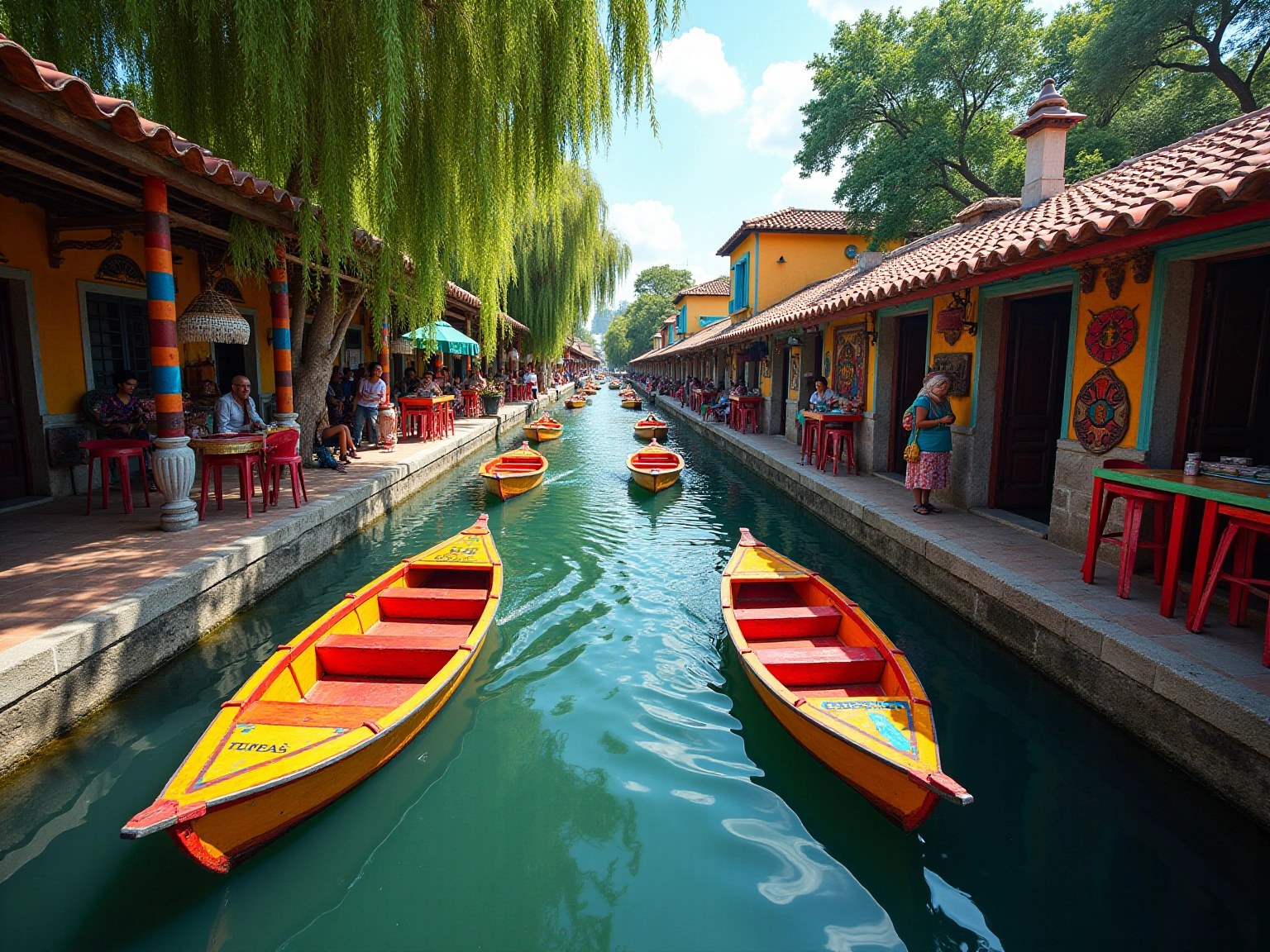
Xochimilco Canals: A UNESCO World Heritage Site
The canals in Mexico, recognized as a UNESCO World Heritage Site in 1987, are a remarkable testament to the country’s rich history and ecological diversity! This ancient canal system, developed by the Aztecs, showcases innovative agricultural practices, especially the chinampa farming method, which uses floating gardens to cultivate crops sustainably. Since 1978, a total of 1,031 properties have been inscribed as World Heritage Sites, with annual inscriptions highlighting the ongoing acknowledgment of historical and ecological importance. This area is not only notable for its distinctive ecosystem but also for its historical significance.
These canals provide a vital habitat for various species and embody the cultural identity of the region, making them essential for both ecological balance and historical appreciation. Recent studies, like the 2014 census of axolotl populations in a certain area, revealed alarming declines, with fewer than 35 axolotls per square kilometer! This underscores the urgent need for conservation efforts to protect this unique species and its habitat. The findings from this census have sparked further research and conservation initiatives aimed at preventing the potential extinction of the axolotl in its native habitat.
Experts emphasize the importance of passing down traditional chinampa farming knowledge to future generations. Miguel del Valle, for instance, advocates for sustainable practices amidst environmental challenges. Felipe Barrera, a chinampero, shares his experience: “I began to collect rainwater in tanks that, [although] they are not exactly a secondary canal, they can serve as storage.” This illustrates the innovative approaches being adopted in the region.
The ecological significance of the Xochimilco canals goes beyond their beauty; they play a vital role in preserving biodiversity and supporting regional economies through tourism and agriculture. The UNESCO designation has significantly impacted local economies, enhancing tourism and promoting sustainable practices. Exploring these canals offers a fantastic opportunity to engage with Mexico’s heritage while supporting sustainability and conservation initiatives!
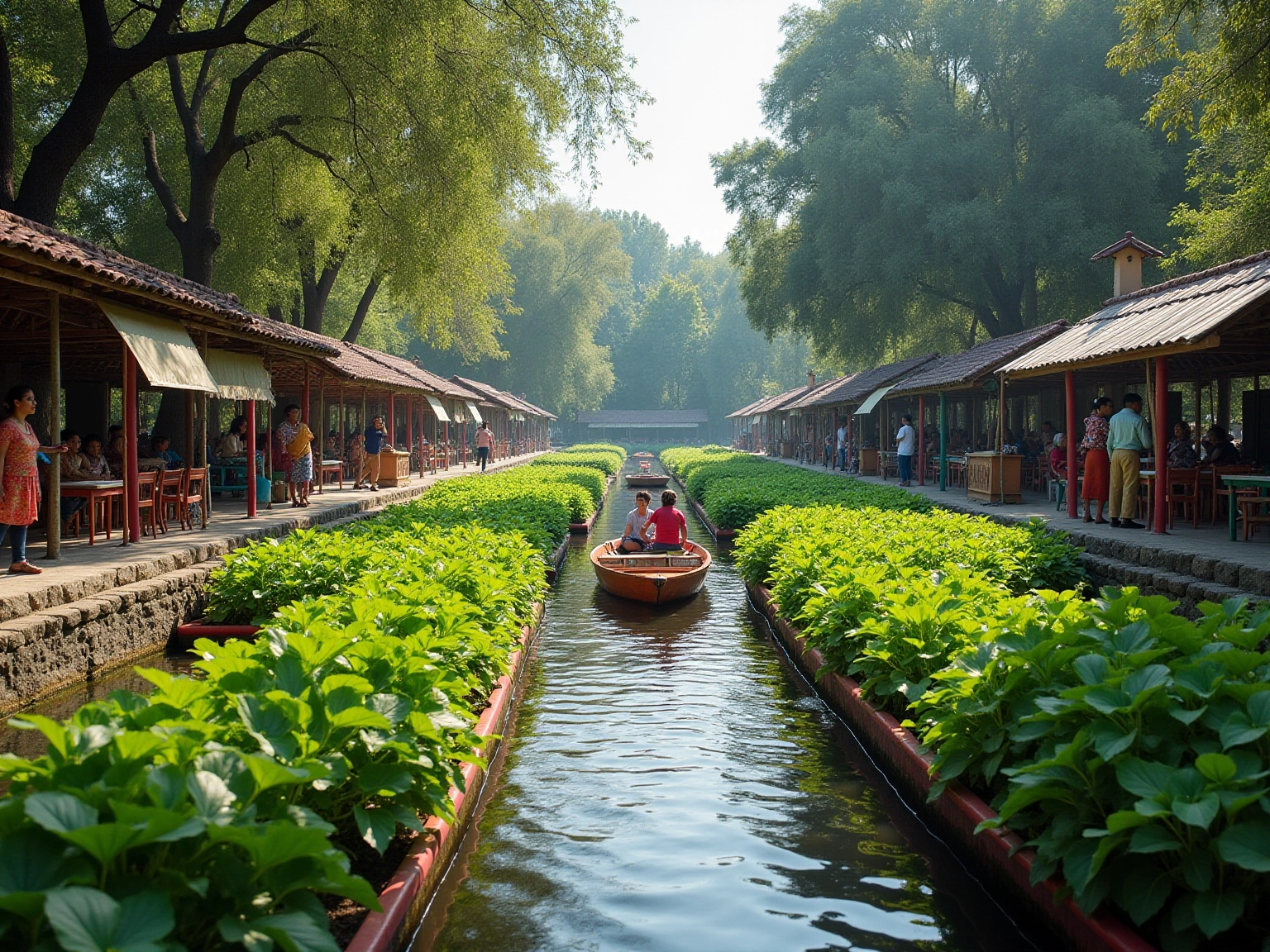
Trajinera Rides: Experience the Heart of Xochimilco
A ride on a trajinera is truly an unforgettable adventure through the enchanting canals of Mexico City, capturing the essence of genuine exploration! These vibrant boats, often adorned with intricate decorations, offer a unique perspective to soak in the lush landscapes and the lively atmosphere of the area. As you glide along the waterways, the sounds of traditional mariachi music fill the air, enhancing the festive spirit that characterizes this vibrant center.
You can indulge in delicious street food from nearby vendors, creating a perfect blend of relaxation and cultural engagement. With over 1.5 million visitors annually, trajinera rides through the canals of Mexico City have become a must-do activity for anyone seeking authentic experiences in the city. The Xochimilco Boat Tour, a UNESCO World Heritage site, not only showcases the beauty of the canals in Mexico City but also immerses you in regional traditions. You can enjoy interactive games like ‘Lotería’ and sip on traditional drinks such as ‘aguas frescas.’
This engaging storytelling and cultural immersion resonate with Karen LeBlanc’s insights on how every destination tells a story through its local art and culture, making the tour highly recommended for both solo travelers and groups. Picture yourself in a lively environment where each ride is a celebration of Mexican culture, guaranteeing that your time is both unforgettable and enriching! As Angélica Román beautifully puts it, ‘Siempre con la cámara en mano viendo la vida a través del lente.’
Additionally, initiatives like MexiTrajas promote diversity, respect, and environmental care, ensuring an enjoyable experience for all while highlighting the commitment to sustainability in tourism.
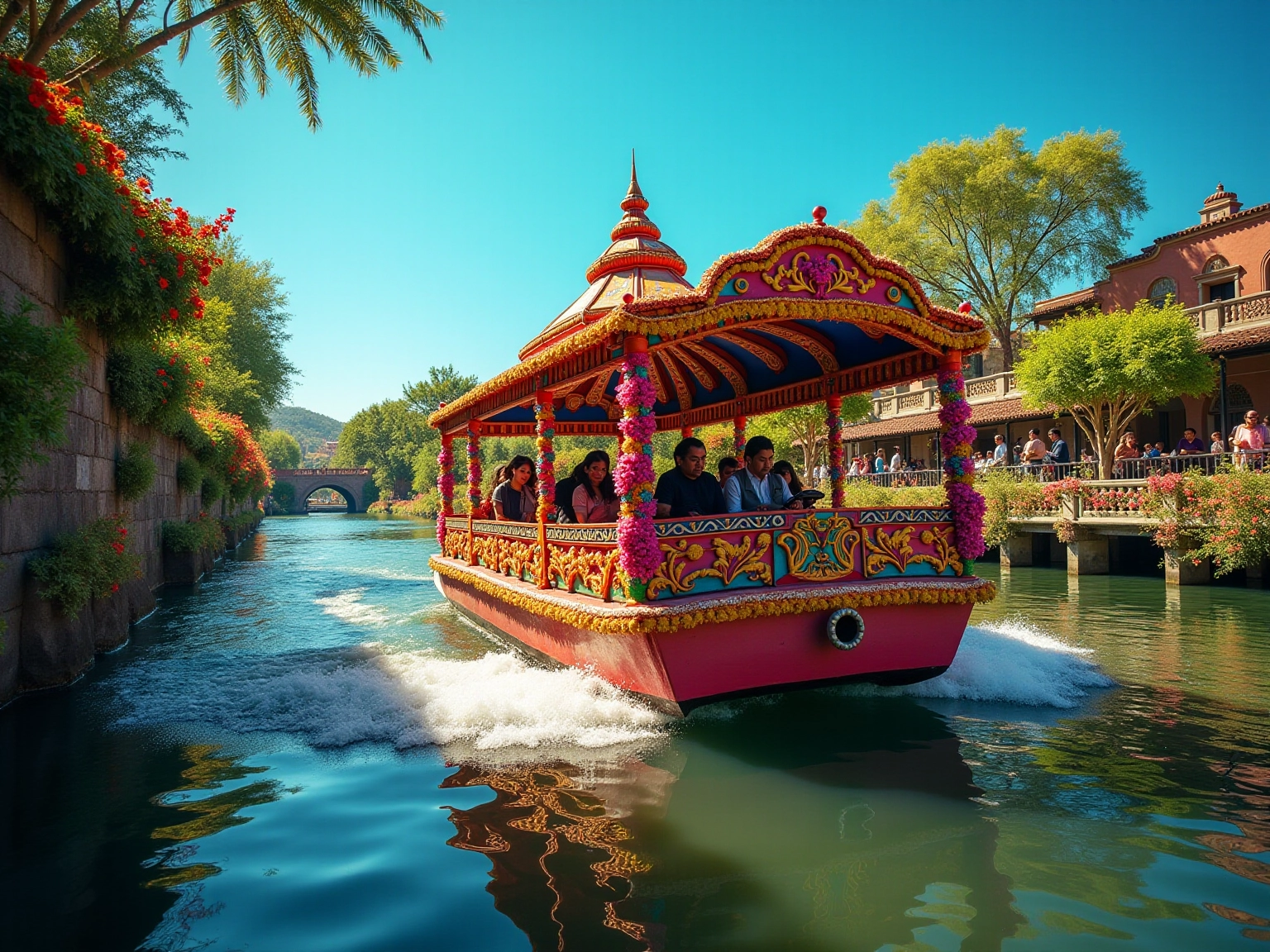
Chinampas: The Floating Gardens of Xochimilco
Chinampas, often called floating gardens, are a fascinating agricultural innovation that hails from the Aztecs! These small, man-made islands are crafted by weaving together reeds and mud, allowing for incredibly productive farming right in the shallow waters of the canals in Mexico City. Imagine visiting Xaltocan, where a case study reveals that this integrated raised field and chinampa system could produce a significant caloric surplus—enough to exceed the needs of the local population and the laborers involved in full production!
When you explore this area, you can truly immerse yourself in this unique ecosystem. You’ll learn about sustainable farming methods and even buy fresh produce directly from nearby farmers! This ancient agricultural system not only promotes biodiversity but also plays a vital role in preserving Mexico’s rich heritage.
Recent studies show just how important chinampas are for food security and poverty reduction, especially as we face the challenges of climate change. As Ricardo Rodríguez, founder and director of De la Chinampa a tu Mesa, points out, “Awareness-raising programmes are needed for their descendants to start to recuperate the chinampas, improve the cleaning system, and acknowledge the farmers.”
As awareness grows, exciting initiatives are underway to revitalize these vital landscapes. Isn’t it inspiring to think that the legacy of chinampas can continue to thrive for future generations? You won’t want to miss out on discovering this incredible aspect of Mexico’s agricultural history!
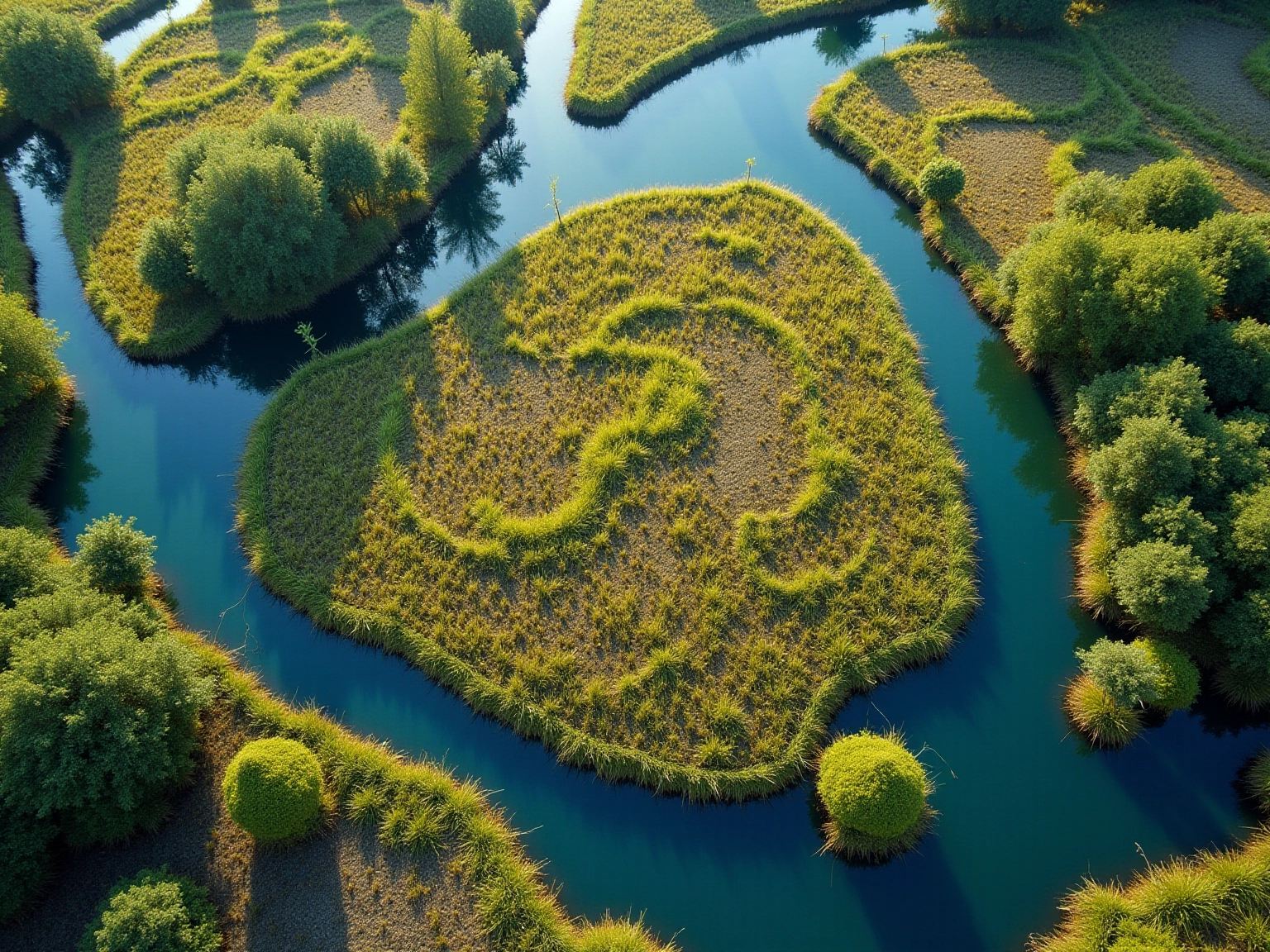
Festivals and Events: Celebrate Local Culture in Xochimilco
This vibrant center of cultural celebrations truly embodies the spirit of regional traditions! Events like the Day of the Dead, the Flower Festival, and the Carnival draw both locals and tourists, creating an atmosphere bursting with colorful parades, traditional music, and mouthwatering cuisine. Imagine indulging in pan de muerto, a sweet bread that enhances the festive vibe, allowing both residents and visitors to savor this culinary delight. These festivities not only offer an immersive experience but also foster a deep connection between participants and the community, inviting you to appreciate the rich heritage of Xochimilco.
But it gets even better! The impact of these local celebrations goes beyond mere entertainment; they play a crucial role in shaping community identity and boosting tourism. In 2025, we can expect attendance at these festivals to soar, reflecting their growing popularity and importance in encouraging community involvement. For instance, past attendance figures have shown a steady increase, indicating a trend toward greater participation.
As Sofia Rios aptly puts it, ‘The Mexican spirit thrives in our collective support.’ This really emphasizes how these events bring the community together, celebrating its unique narrative. Plus, the San Lorenzo Tlaltecpan Church, located in a district known for its fishermen, adds a layer of historical richness that enhances the artistic environment of the area.
This societal narrative resonates with the themes explored at the National Hansen’s Disease Museum, where local traditions and histories are preserved and celebrated. It’s similar to the UNESCO Biosphere of Saarland, which highlights the importance of heritage in environmental conservation. Both contexts underscore the significance of community involvement in maintaining cultural identities—just like the lively festivities in this region!
Culinary Delights: Savor Local Flavors Along the Canals
Culinary exploration along the canals Mexico City is an absolute must for any food enthusiast! Picture this: a vibrant atmosphere buzzing with nearby vendors offering a delightful array of traditional Mexican dishes. You’ll find tacos, quesadillas, and tamales, all made from fresh ingredients sourced from the region’s unique chinampas.
Mercado X is your go-to spot, operating from 8 am to 6 pm, and it’s packed with chances to indulge in regional specialties like ‘tlacoyos’—thick corn tortillas filled with various ingredients—and ‘pulque,’ a traditional fermented beverage that has been enjoyed for centuries.
But wait, there’s more! Hop on a trajinera ride—the colorful boats that navigate the canals Mexico City—and you’ll discover even more food options. It’s a fantastic way to savor the rich flavors of the area while soaking in the scenic views. This culinary journey not only showcases the region’s gastronomic heritage but also supports local food vendors, making a significant contribution to the area’s tourism economy.
Think about the whisky tourism in Scotland; it’s clear that gastronomic activities can attract international travelers, highlighting the importance of culinary tourism.
As Ben Herrera notes, “In Mexico, unlike in its neighbors to the North, there really isn’t a strong pro-organic movement,” which offers a unique perspective on the local food culture. The rising enthusiasm for culinary experiences is evident in recent reports on Mexico’s culinary tourism market, showcasing how regional food vendors are influencing tourism in the area.
This exploration of local flavors not only delights your taste buds but also connects you to the authenticity and creativity that shape the artistic landscape of Mexico. So, are you ready to dive into this delicious adventure?
Ecological Tours: Explore Xochimilco’s Natural Beauty
Xochimilco is truly a cultural and ecological gem, offering you a unique chance to dive into its rich biodiversity! Ecological tours invite you to immerse yourself in the vibrant ecosystems of the canals of Mexico City and chinampas, showcasing a delightful variety of flora and fauna. You can enjoy popular activities like birdwatching, kayaking, and guided nature walks, all of which let you appreciate the stunning natural beauty of this UNESCO World Heritage site firsthand.
These tours not only highlight the area’s ecological significance but also shed light on the critical conservation efforts needed to protect its unique habitats. For example, while some chinampa farmers use organic farming practices, others still rely on pesticides, which raises concerns about the impact on local biodiversity. Did you know that maintaining a ‘refuge chinampa’ for species like the axolotl can cost up to 100,000 pesos? This illustrates the financial challenges associated with conservation initiatives and the need for adequate funding to support these efforts.
Local vendors play a vital role in enhancing your experience, offering food, drinks, and souvenirs that reflect the area’s rich cultural heritage. Just a heads up—be discerning, as some prices may be inflated. To spot authentic products, look for items that are locally made and don’t hesitate to ask about the sourcing of goods. The importance of conservation in the region is echoed by experts like Óscar Camacho, who notes, “The chinampa area is considered a conservation zone… but the government has allowed the settlements to grow.” This highlights the ongoing challenges in protecting this ecological treasure.
Participating in these ecological tours around the canals of Mexico City not only enriches your travel experience but also fosters a deeper understanding of the complex relationship between culture and nature in this captivating region. So, are you ready to explore Xochimilco and uncover its wonders?
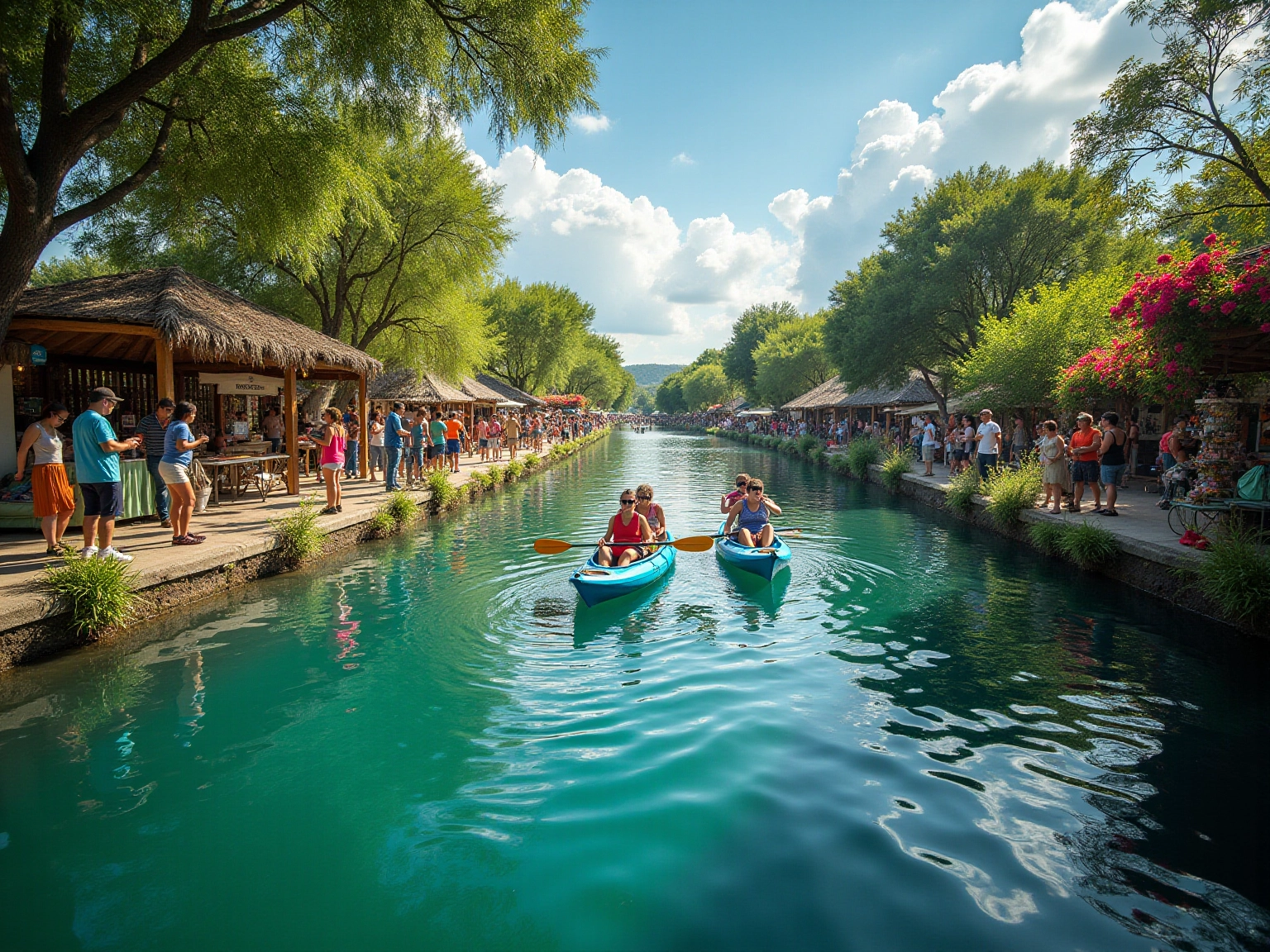
Historical Significance: The Story of Xochimilco
The history of Xochimilco is deeply rooted in the Aztec civilization, where it blossomed as a vital agricultural center. Imagine the sophisticated canals in Mexico City, designed to boost trade and transportation, allowing for the seamless movement of goods and people throughout the region. This intricate network not only fueled the local economy but also shaped the identity of the Aztecs. Today, when you visit, you can witness the remnants of this rich heritage through the area’s architecture, traditional farming practices, and vibrant customs that continue to thrive!
A fascinating case study on the environmental and socio-economic sustainability of chinampas in Mexico underscores the historical importance of these agricultural systems. While modern plastic greenhouses have become more lucrative, they threaten the ecosystem and historical landscape. In contrast, chinampas, despite their shift toward commercial horticulture, provide irreplaceable ecosystem services that echo the enduring legacy of Aztec agricultural practices.
Local inhabitants express a strong desire to protect this area for future generations, emphasizing the importance of preserving this distinctive heritage. As Karen LeBlanc, creator of The Design Tourist, pointed out, “The island was featured on the Travel Channel show Ghost Adventures and the Amazon Prime Lore,” showcasing its ongoing cultural relevance. Understanding the historical context of this location enriches your visit, allowing you to appreciate the significant influence of the Aztec civilization on contemporary practices and the continuous efforts to preserve this UNESCO World Heritage site.
Safety Tips: Navigating Xochimilco Responsibly
While this location is generally safe for you as a visitor, taking a few precautions can truly enhance your experience. Here are some key safety tips to consider:
- Stay Aware: Always keep an eye on your surroundings and make sure your belongings are secure to avoid pickpocketing, especially in crowded areas.
- Travel in Groups: Whenever you can, explore in groups! It’s especially fun during peak times when the area is buzzing with visitors.
- Negotiate Prices: Before hopping on a trajinera (that’s a traditional boat), agree on the fare to steer clear of any misunderstandings later on. A one-way journey from places like Roma and Condesa to the canals Mexico City typically averages around MX$400 Pesos (about $20 USD), so planning for this can really help you organize your visit.
- Be Cautious with Food: When it comes to food and drinks from street vendors, a little caution goes a long way to ensure your health and safety.
- Engage with Community Guides: Connecting with community guides can enrich your journey and provide you with valuable insights about the region, making your visit even more rewarding.
I recommend visiting during daylight hours, as the area comes alive from early morning until late evening, with weekends being especially vibrant. This not only boosts safety but also lets you soak up the lively atmosphere. As Karen LeBlanc wisely suggests, “Get acquainted with typical local scams to prevent being deceived and have a smooth time in Mexico City.” By following these tips, including staying in different neighborhoods, you can navigate the area responsibly and truly make the most of your cultural exploration.
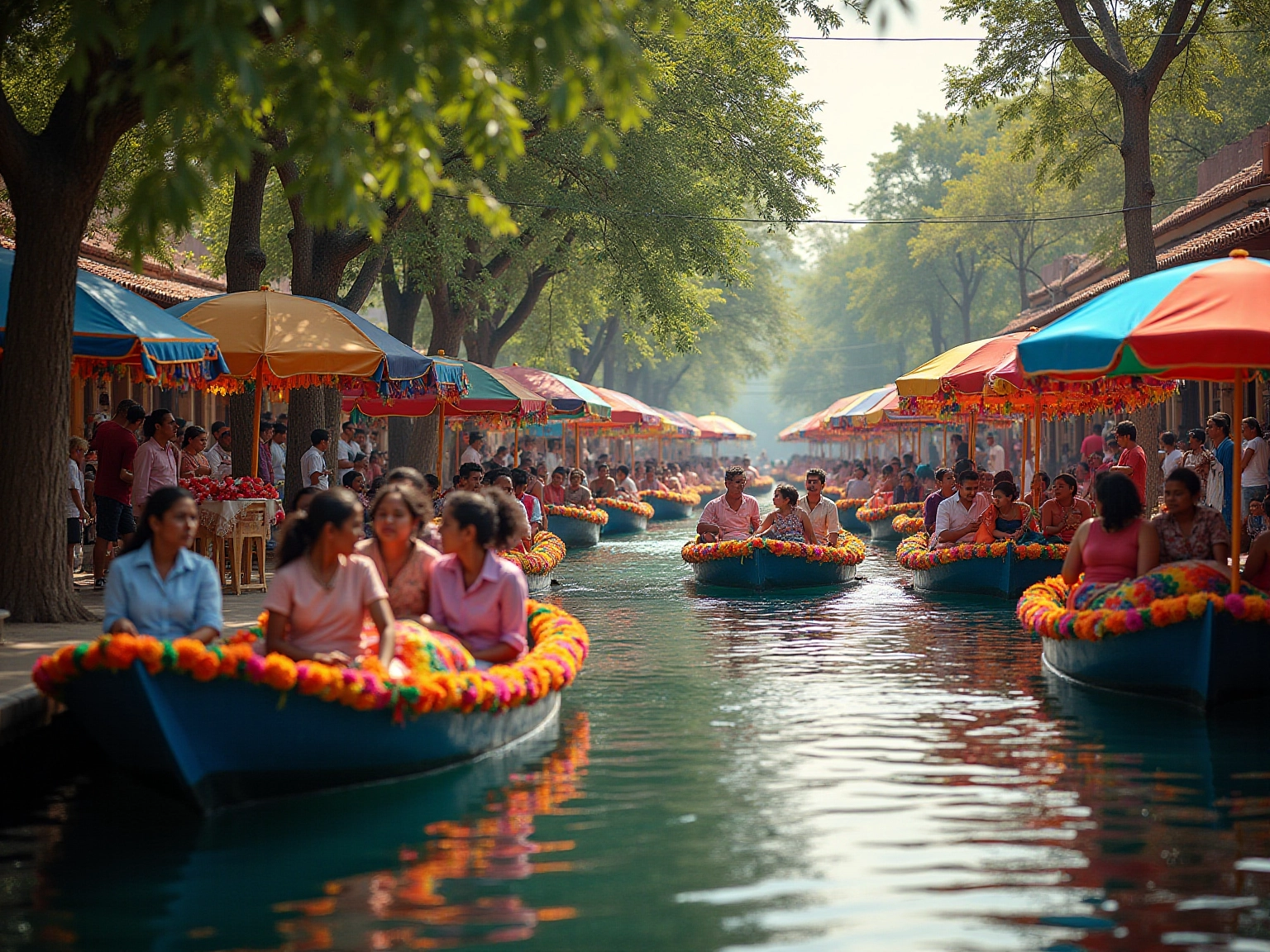
Planning Your Visit: Essential Tips for Exploring Xochimilco
To maximize your experience in Xochimilco, keep these essential tips in mind:
- Timing is Key: Aim to visit on weekdays or early in the morning to sidestep the crowds and enjoy a more serene atmosphere. Be mindful of traffic conditions, especially during rush hour, as roads can be busier and may increase your travel costs back to Mexico City.
- Plan for Duration: Allocate at least 3-4 hours to fully immerse yourself in the canals of Mexico City and explore nearby attractions, like the Museo Dolores Olmedo, which is just a 10-minute drive from Embarcadero Nuevo Nativitas.
- Cash is King: Bring cash for food and boat rentals, as many vendors do not accept credit cards. A typical rental rate for a trajinera is around 500 pesos per hour, approximately $25.
- Dress Comfortably: Wear comfortable clothing and apply sunscreen, as you’ll be spending significant time outdoors under the sun.
- Engage with Local Culture: Research local festivals and events occurring during your visit, such as the Day of the Dead celebrations or the Flower Festival, to enrich your experience and connect with the vibrant culture of the region.
- Safety First: Remain cautious and aware of your surroundings, especially in certain neighborhoods, to ensure a safe and enjoyable visit.
With these tips, you’re well-prepared for an unforgettable adventure in the enchanting canals of Mexico City.
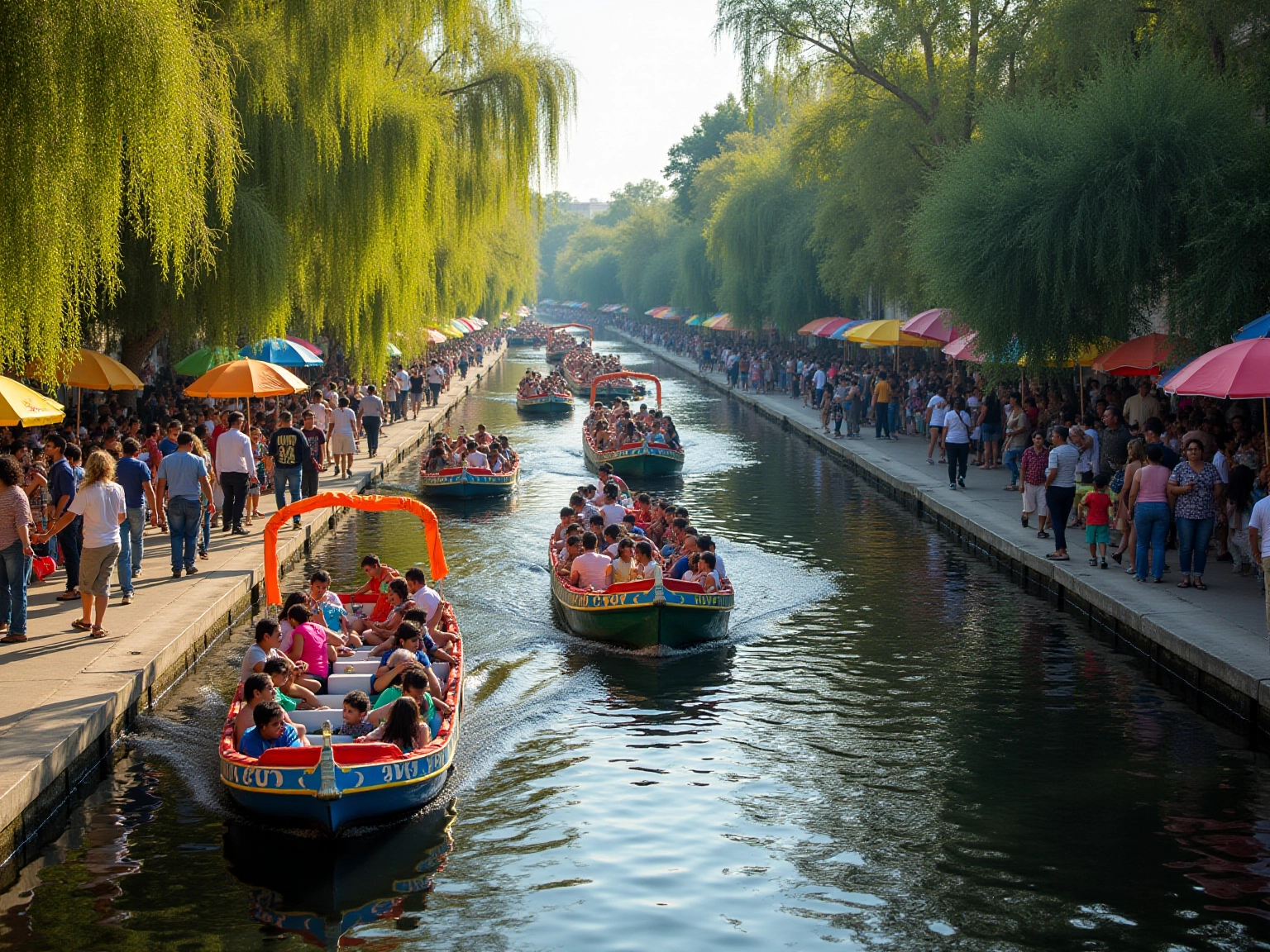
Conclusion
Xochimilco is not just a picturesque destination; it’s a vibrant tapestry of history, tradition, and ecological significance just waiting for you to explore! Imagine gliding through its colorful canals, experiencing the innovative chinampas farming system, and enjoying lively trajinera rides that bring the local culture to life. Every moment here invites you to dive in and appreciate the beauty around you.
But let’s not forget the challenges this UNESCO World Heritage Site faces. Conservation efforts and the push for sustainable tourism highlight the vital role of community resilience and cultural preservation. When you engage with local traditions—whether through festivals, delicious food, or ecological tours—you’re not just a visitor; you’re a part of the ongoing story of Xochimilco, where history and modern life blend seamlessly.
Ultimately, your journey through Xochimilco offers more than just sights and sounds; it’s a chance to connect with the heart of Mexican culture and the urgent need for environmental stewardship. By valuing its rich history and ecological diversity, you can play a key role in ensuring this enchanting district thrives for generations to come. Embracing the magic of Xochimilco means understanding its story, celebrating its heritage, and committing to its future. So, are you ready to discover the wonders of Xochimilco?
Frequently Asked Questions
What is Xochimilco known for?
Xochimilco, often referred to as the “Venice of Mexico,” is renowned for its intricate canals, vibrant culture, colorful trajineras (boats), lively traditional music, and unique artisanal crafts. It is a UNESCO World Heritage Site, emphasizing its rich heritage and cultural significance.
What challenges does Xochimilco tourism face?
Xochimilco tourism faces challenges such as limited financial resources for conservation projects, community conflicts, and the need to promote sustainable tourism and agriculture, particularly regarding regional chinampa products affected by pollution concerns.
What is chinampa farming?
Chinampa farming is an innovative agricultural practice developed by the Aztecs, utilizing floating gardens to cultivate crops sustainably. This method is integral to the ecological and cultural landscape of Xochimilco.
How does the UNESCO designation impact Xochimilco?
The UNESCO designation enhances local economies by promoting tourism and encouraging sustainable practices, while also highlighting the historical and ecological importance of the Xochimilco canals.
What is a trajinera ride like?
A trajinera ride is an engaging adventure through the canals of Mexico City, featuring vibrant boats decorated intricately. Visitors can enjoy traditional mariachi music, delicious street food, interactive games, and regional drinks, creating a festive and culturally immersive experience.
How many visitors does Xochimilco attract annually?
Xochimilco attracts over 1.5 million visitors annually, making trajinera rides a must-do activity for those seeking authentic cultural experiences in Mexico City.
What efforts are being made to promote sustainability in Xochimilco?
Initiatives like MexiTrajas promote diversity, respect, and environmental care, ensuring enjoyable experiences while highlighting a commitment to sustainability in tourism. Additionally, there are efforts to enhance the perceived value of chinampa products through education and promotion.
Why is the preservation of Xochimilco’s heritage important to the community?
The preservation of Xochimilco’s heritage is vital to the community’s identity, as it reflects their traditions and practices. Local sentiments emphasize that their heritage is of interest to tourists, fostering a beautiful relationship between local culture and visitor experiences.









